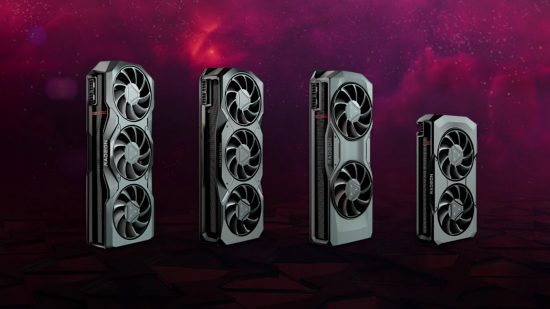The AMD Radeon RX 7000 series is available now, with graphics card prices and performance that cater to budget-minded and big-spending gamers alike. To help you figure out which GPU is the best fit for your gaming rig, we’ve shared everything you need to know about the AMD RDNA 3 GPU family.
As competition for the title of best graphics card remains as fierce as ever, AMD isn’t holding back with its Radeon RX 7000 series. These new GPUs are the company’s most powerful to date, with improved ray tracing and rasterization performance.

How much do AMD Radeon RX 7000 graphics cards cost?
You can expect to pay a minimum of $269 for an entry-level Radeon RX 7000 graphics card, with the most expensive AMD GPU in the range costing a minimum of $999.
- AMD Radeon RX 7900 XTX – $999
- AMD Radeon RX 7900 XT – $899
- AMD Radeon RX 7800 XT – $499
- AMD Radeon RX 7700 XT – $449
- AMD Radeon RX 7600 XT – $329
- AMD Radeon RX 7600 – $269
Looking at the entire Radeon RX 7000 series stack, we believe that the Radeon RX 7800 XT offers the best value for most people. It only costs $50 more than the Radeon RX 7700 XT but provides a larger VRAM capacity of 16GB and higher levels of performance.
For those on a budget, we recommend opting for the RX 7600. Paying the extra $60 for the RX 7600 XT only makes sense if you’re in need of the extra VRAM, as the performance difference between the two cards is otherwise identical. However, there is an argument to be made that the more expensive card will be more “futureproof” thanks to its higher memory capacity.
While the Radeon RX 7900 XT initially launched with an $899 MSRP, you can often find it well below this price point. With this volatility in mind, choosing between it and the Radeon RX 7900 XTX becomes difficult. At their normal cost, however, the more expensive graphics card is the better option.

What are the specs of Radeon RX 7000 graphics cards?
The entire Radeon RX 7000 series uses GPUs built on AMD’s RDNA 3 microarchitecture. This notably includes second-generation ray accelerators and infinity cache, as well as other improvements.
The Radeon RX 7900 XTX is the most stacked of the Radeon RX 7000 series when it comes to specs, powered by AMD’s Navi 31 XTX GPU with 96 ray accelerators and compute units. This in addition to a whopping 24GB of GDDR6 VRAM, making it more than capable of handling 4K textures with ray tracing and then some.
Naturally, less expensive models feature less powerful specifications. While spec sheets can provide some understanding of a graphics card’s capabilities, it isn’t until the silicon is put to the test in benchmarks that we can extrapolate any performance estimates.

How do AMD Radeon RX 7000 graphics cards perform in benchmarks?
In our benchmarks, AMD Radeon RX 7000 GPUs beat the competition from Nvidia in games with rasterized rendering. However, their ray tracing capabilities aren’t nearly as strong, while FSR and DLSS complicate the situation further.
Check out our reviews for each AMD Radeon RX 7000 series graphics card for more detailed information on how they perform. We’ve tested each of them at 1080p, 1440p, and 4K, both with and without ray tracing.
Here are our AMD Radeon RX 7000 reviews:
- AMD Radeon RX 7600 review
- AMD Radeon RX 7600 XT review
- AMD Radeon RX 7700 XT review
- AMD Radeon RX 7800 XT review
- AMD Radeon RX 7900 XT review
- AMD Radeon RX 7900 XTX review

Where can I buy AMD Radeon RX 7000 graphics cards?
Radeon RX 7000 graphics cards are available from major retailers such as Amazon, Best Buy, and others, as well as directly from AMD itself.
Here are some great deals on Radeon RX 7000 graphics cards right now:
Be sure to check our best graphics card guide to learn more about alternatives to the AMD Radeon RX 7000 series from both Nvidia and Intel, featuring additional summaries and reviews.
